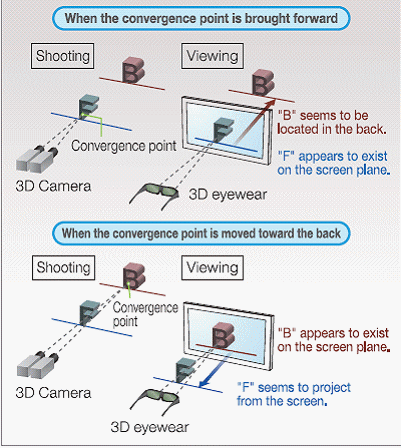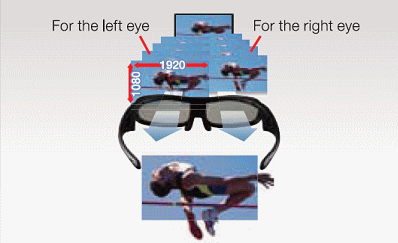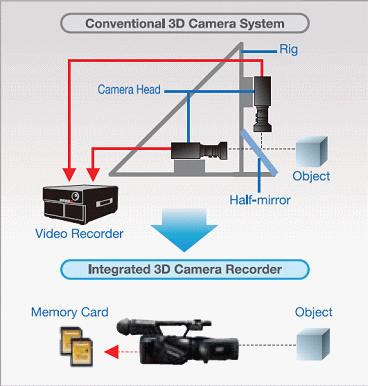 |
| | A | B | C | D | E | F | G | H | I | J | K | L | M | N | O | P | Q | R | S | T | U | V | W | X | Y | Z | 0-9 | |
| ▌A |
Active shutter glasses A type of 3D eyewear. Active shutter glasses have LCD shutters that are timed to open and close alternately for each frame or field to separate left-eye and right-eye images, thus allowing the viewer to perceive 3D images. Panasonic FULL HD 3D plasma display and FULL HD 3D Plasma TVs active shutter glasses operate at a high speed of 120 Hz and use infrared for synchronizing with the display. Amount of parallax See Parallax |
| ▌B |
Blu-ray 3D™ Blu-ray 3D™ is a standard for recording 3D images on Blu-ray Discs. It was announced in December 2009. This standard was established to enable the viewing of 3D movies at home with theater-like quality, in response to the recent commercial success of 3D movies. The Blu-ray 3D specifications are based on the MVC (Multiview Video Coding) standard, which is an extended version of the MPEG-4 AVC (Advanced Video Coding) standard supported by all Blu-ray Disc™ players available today. The MPEG-4 MV format compresses the left-eye and right-eye images to a data amount that is about 1.5 times more than the data for equivalent 2D content. It offers backward compatibility so that existing 2D Blu-ray Disc™ players can play back 3D Blu-ray Discs with 1080i/p full-HD image quality. Also, because the Blu-ray 3D™ specifications incorporate an enhanced graphic function for 3D, they allow the display of a 3D graphic menu for disc content navigation as well as 3D subtitles on 3D videos. |
| ▌C |
Checker sampling technology The checker sampling technology is one of the 3D video signal display technologies. With this technology, the left-eye and right-eye images are arranged in a checker pattern using individual pixels on the screen. As a result, image information is delivered by half the number of full-HD pixels per eye. This system uses polarized glasses to separate the left-eye and right- eye images.
Convergence point The convergence point is a point where the optical axes of the two lenses of a twin-lens camera meet. On the 3D display, objects located in front of the convergence point appear to project from the screen toward the viewer, while those behind the convergence point seem to be located in the back of the display plane. By varying the convergence point, the feeling of depth can be adjusted. The convergence point adjustment function is essential for designing 3D effects. |
| ▌F |
|
|
| ▌H |
HDMI 1.4 HDMI (High-Definition Multimedia Interface) 1.4 was developed by adding functions to support the HDMI Ethernet channel (HDMI HEC), audio return channel (ARC), 3840 x 2160 and 4096 x 2160 resolution, SYCC601, Adobe RGB, Adobe YCC601 and 3D video as well as Micro HDMI definition and the automotive connection system definition to the HDMI 1.3 standard. The HDMI 1.4 specifications were announced in May 2009. |
| ▌ I |
Integrated Twin-lens 3D Camera Recorder A type of 3D camera system. A twin-lens 3D camera section and a recorder section are combined into the integrated twin-lens 3D camera recorder. Since the twin-lens 3D camera section is mounted on the frame of the camera recorder, it does not require frequent optical axis adjustment as compared to a rig-type 3D camera system, and also offers excellent mobility and flexibility. Inter-axial (Inter ocular/Inter
pupillary) distance |
| ▌L |
Line-by-line technology (interleave system) The line-by-line technology is one of the 3D video signal transmission/display technologies. With this technology, the left-eye and right-eye images are allocated to the field (scanning lines) of odd-number lines and the field of even-number lines, respectively. While its advantage is that the conventional video signal bandwidth can be used for signal transmission, it decreases the horizontal resolution to one-half. Horizontal resolution is maintained. For display systems adopting the line-by-line technology, polarized filters with different polarizing directions for the two fields are attached on the display surface and polarized glasses are used to separate the left-eye and right-eye images. |
| ▌M |
MPEG-4 AVC MPEG-4 AVC is a motion image data compression coding system. AVC stands for Advanced Video Coding. It was established for a wide range of uses, ranging from low-rate, low-image-quality applications such as the videoconferencing function of mobile phones and webstream video to high-rate, high-image quality applications such as HD broadcasting. MPEG-4 AVC compresses data to about 1/2 the size achieved by the popularly used MPEG-2 format in the past, while keeping the image quality. MPEG-4 AVC is used in the AVCHD format and for Blu-ray Discs, and also in the AVC-Intra codec for broadcasting applications. MPEG-4 MVC |
| ▌P |
|
Parallax (Binocular parallax) Visual disparity is an angular difference between the lines of sight of the left eye and right eye of a person viewing an object. It sometimes refers to the apparent difference in the images perceived by the left and right eyes. It is believed that the human brain combines and processes the two images seen by both eyes to perceive solidity. Parallax barrier system Polarized glasses |
| ▌R |
Rig-type 3D camera system This is a 3D camera system configured with two conventional camera units and attached to a rig (frame). Two cameras are mounted horizontally in some systems, while a half-mirror type is employed in other systems. Unlike a fully integrated 3D camera system, a rig-type 3D camera system requires precise adjustment of optical axes before shooting. Many rig-type 3D camera systems require separate recording units. |
| ▌S |
Side-by-side technology The side-by-side technology is one of the 3D video signal transmission technologies. It combines left-eye and right-eye images into one frame in a split-screen format. This system is used mainly for 3D broadcasting. While its advantage is that the conventional video signal bandwidth can be used for signal transmission, it decreases the horizontal resolution to one-half. In the case of progressive signals, vertical resolution is maintained, making it suitable for fast-moving 3D images such as sports events. For displaying images, signals are converted to another system (line-by-line, checker flag, frame sequential, etc.).
Simulcast (Dual SDI) System One of the transmission methods for 3D video signals. Simulcast splits the left and right images into two signal lines and transmits them. Dual SDI can transmit full-HD signals (1080i or 1080/24p signals) over two SDI lines. |
| ▌T |
|
|
| ▌X |
|
|
| ▌0-9 |
|
3D eyewear 3D video |






